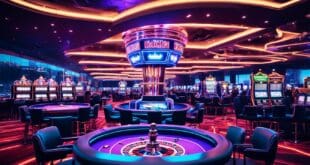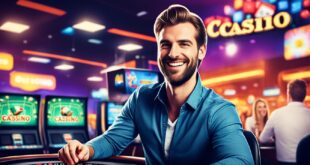The architecture of a casino building plays a crucial role in creating an extravagant and captivating environment that keeps gamblers engaged and wanting to stay longer. The design of gambling spaces should be carefully planned to maximize functionality and prioritize the comfort and experience of the guests. From iconic casino designs to the psychology of casino layouts, every element is meticulously crafted to create a casino architecture that enhances the overall gambling experience.
Key Takeaways:
- Casino architecture is essential to create an extravagant and captivating environment for gamblers.
- The design should prioritize functionality, comfort, and the overall guest experience.
- The psychology of casino layouts is carefully considered to keep players engaged and immersed in the gambling experience.
- Iconic casino designs serve as architectural marvels and landmarks, attracting millions of visitors.
- Casino architecture continues to evolve with technological advancements and changing industry trends.
Small Casino Design 101: What Experts Tell You To Follow
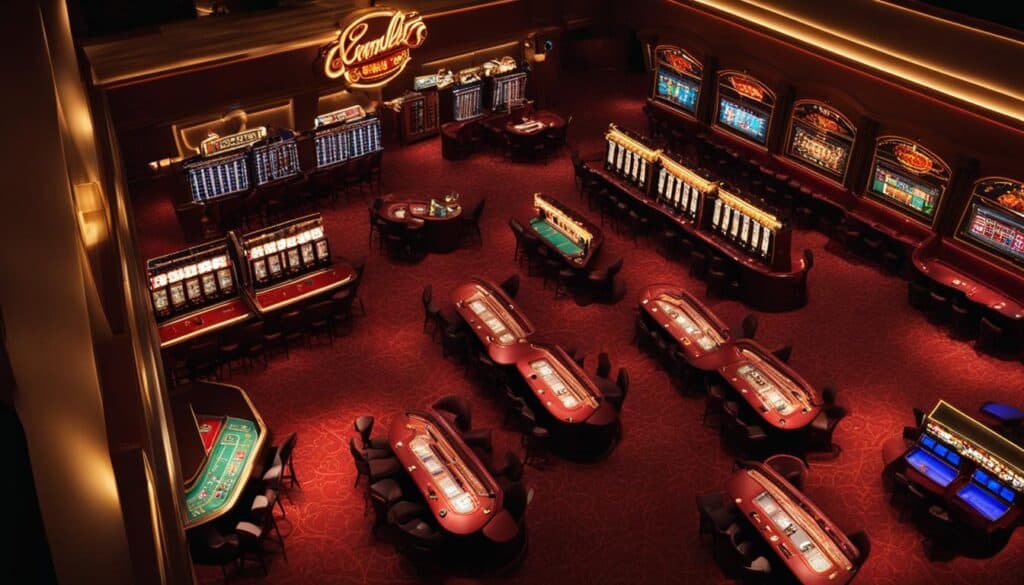
When it comes to designing a small casino, experts emphasize the importance of careful planning and utilizing the limited space available. The design should aim to create a vacation-like atmosphere where gamblers can fully immerse themselves in the casino games and have an unforgettable experience.
One key consideration in small casino design is effective space allocation. Gaming areas should be strategically placed to maximize functionality and convenience for the guests. Allocating space for food and beverage corners ensures that players can enjoy refreshments without having to venture far from the gaming floor. Parking spaces should also be adequately provided to accommodate the needs of casino visitors.
Guest experience is a critical aspect of small casino design. Creating a comfortable and luxurious environment is essential to make players feel like VIPs. Incorporating comfortable seating, elegant decor, and high-quality amenities can greatly enhance the overall guest experience.
Furthermore, small casinos can benefit from incorporating online casino games and interactive features. By integrating digital platforms into the casino design, players can enjoy a seamless transition between physical and virtual gambling experiences, expanding the range of games and entertainment options available to them.
Flexibility in space allocation is also important for small casinos. Multi-utility spaces can be utilized for different purposes, allowing the casino to adapt to the changing needs and preferences of its guests. For example, a multi-utility space can be transformed into a performance area for live entertainment, a conference room for corporate events, or a lounge for relaxation.
In summary, small casino design requires careful planning and utilization of space. Prioritizing guest experience, efficient space allocation, and creating a versatile environment are key factors to consider. By incorporating these principles, small casinos can create an enjoyable and immersive gambling environment that keeps players coming back for more.
The Psychology Behind Casino Design

The design and layout of a casino are carefully crafted to manipulate human psychology and keep players engaged for longer periods. Casino designers utilize various techniques to create an environment that appeals to players’ senses and emotions.
The absence of clocks and clear indicators of time helps players lose track of time and stay immersed in the gaming experience. Without the constant reminder of time passing, players are more likely to stay and continue playing.
The layout and design of pathways and gaming areas are strategically planned to create a sense of exploration and urge players to keep playing. By creating a stimulating and dynamic environment, casinos encourage players to move around and discover new games and experiences.
The use of music, aromas, and visual stimulation further enhances the sensory impact and adds to the overall enjoyment of the casino. Music is carefully chosen to create a specific atmosphere, while pleasant aromas can evoke positive emotions and create a welcoming environment. Visual elements such as colorful displays and dynamic lighting help create excitement and energy within the casino.
By combining these elements, casinos create an immersive experience that captivates players and keeps them engaged. The psychology behind casino design is an integral part of the overall experience and plays a crucial role in maximizing player engagement and enjoyment.
The Influence of Casino Designers Bill Friedman and Roger Thomas
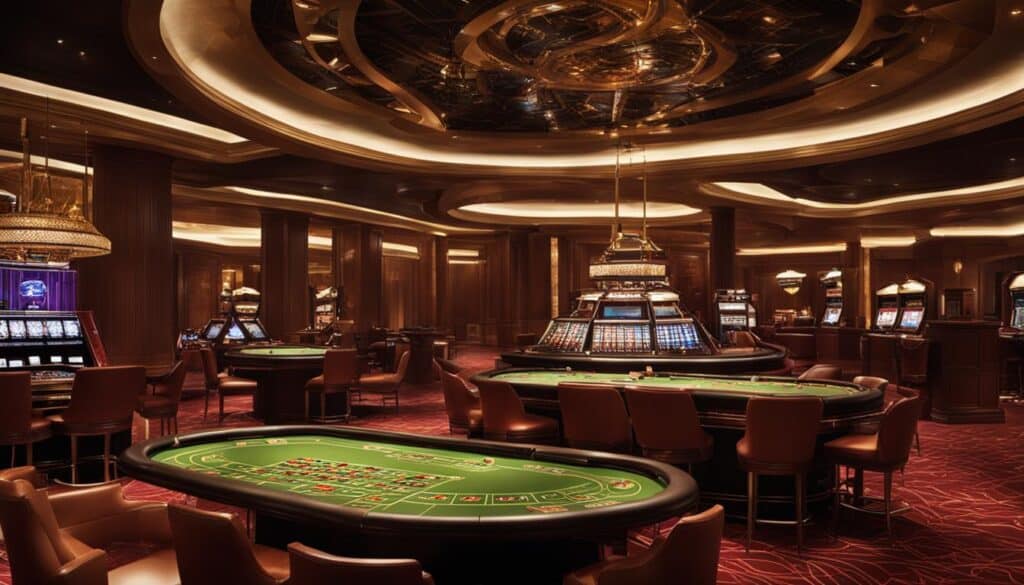
Two influential casino designers, Bill Friedman and Roger Thomas, have significantly impacted the field of casino architecture. Friedman, a former gambling addict, developed design principles based on his personal experience and extensive research. His focus was on maximizing player retention within the casino by eliminating indicators of time, creating a maze-like layout, and emphasizing the importance of gaming machines.
On the other hand, Thomas revolutionized casino design by prioritizing player comfort, relaxation, and clear lines of vision. His design principles centered around creating a pleasant and inviting environment that encourages players to stay longer and take more risks.
“Creating tension and making money,” as described by Friedman, McNeilly, and Dansaroff (1997), sums up his design philosophy, which focuses on captivating players and fostering an addictive gambling atmosphere. His influential book, “Designing Casinos to Dominate the Competition,” outlines his principles and theories.
Thomas, who has been associated with high-profile casino projects such as the Wynn and Bellagio in Las Vegas, prioritized aesthetics and player experience. He believed that creating a visually appealing atmosphere with comfortable seating, pleasing lighting, and attractive decor would entice players to stay longer and enjoy more gaming.
Friedman and Thomas’s contributions have had a profound impact on the industry, influencing casino architecture and design principles that continue to shape player retention and overall casino management strategies today.
Creating a Captivating Casino Environment
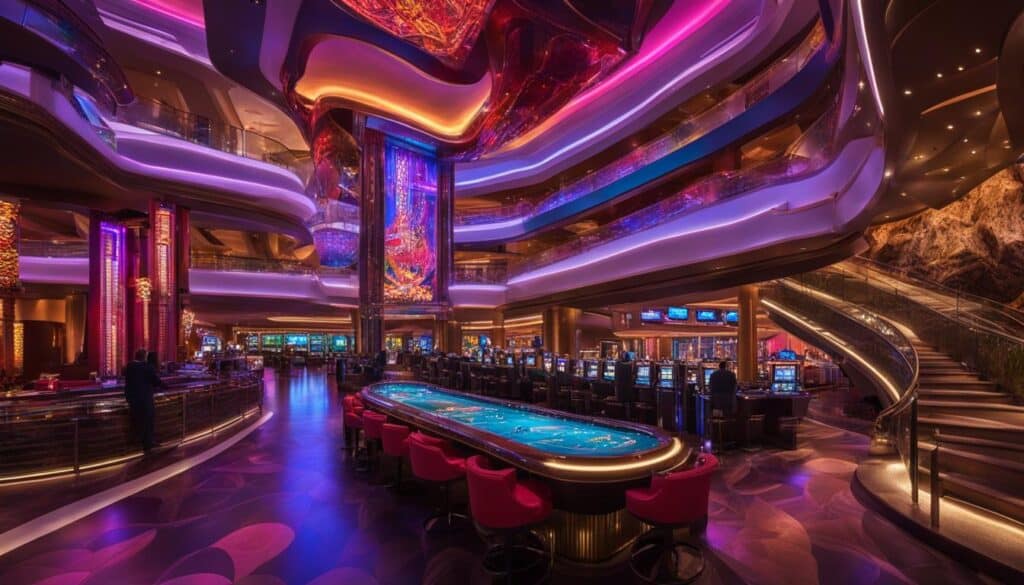
The ambiance and atmosphere of a casino play a crucial role in creating a captivating environment for gamblers. To achieve this, various factors such as lighting, decor, and overall design are carefully considered to contribute to the overall experience.
The lighting in a casino is strategically placed to highlight gaming areas and create a sense of excitement and energy. It is meticulously designed to enhance the thrill of the games and create a captivating visual spectacle for players. Whether it’s the vibrant neon lights of the slot machines or the soft, ambient lighting of the card tables, the illumination sets the mood and adds to the allure of the casino environment.
The decor of a casino is equally important in creating a captivating atmosphere. The choice of furnishings, color schemes, and decorative elements all contribute to the overall theme and ambiance of the space. From opulent chandeliers and luxurious carpets to themed decorations that transport players to different worlds, the decor enhances the immersive experience and adds to the allure of the casino.
Gaming machines, such as slot machines and video poker terminals, are the main focus of any casino. They are strategically placed throughout the casino floor to entice players and create a visually captivating environment. The seamless integration of gaming machines into the overall design ensures that players are constantly surrounded by thrilling gaming options, adding to the excitement and allure of the casino.
In combination, these elements work together to create a visually captivating environment that entices players to stay and gamble. The captivating casino environment, with its carefully selected lighting, stunning decor, and seamless integration of gaming machines, provides an immersive experience that keeps players engaged and fascinated as they indulge in their favorite games.
The Power of Intimacy in Casino Design
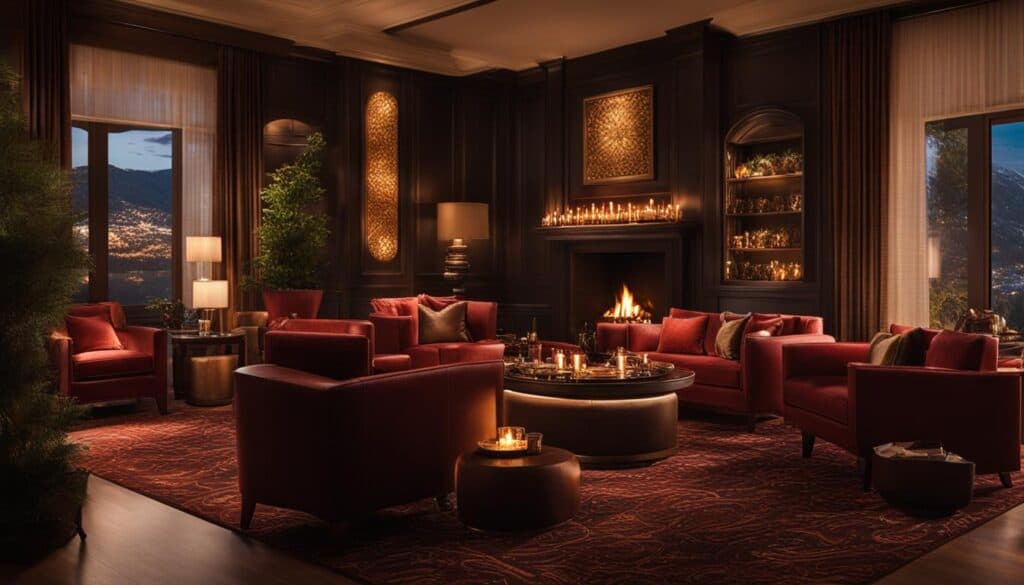
Creating a sense of intimacy in casino design is essential for keeping players engaged and comfortable. By incorporating the use of smaller rooms and segmented areas, casinos can provide different vibes and atmospheres that coexist within a single establishment. These smaller spaces not only encourage exploration but also offer a more personalized experience for players, catering to their individual preferences and gaming styles.
One effective way to create a sense of intimacy is through the implementation of low ceilings, which helps to create a more enclosed and cozy atmosphere. Coupled with strategically placed seating areas, this design element fosters a feeling of exclusivity and allure, making players more inclined to stay and play.
Additionally, the layout of the casino should facilitate easy navigation, ensuring that players can easily locate themselves within the premises. Clear signage and well-defined pathways are crucial in guiding players to different gaming areas, reducing confusion, and enhancing the overall experience.
“The use of intimate spaces in a casino design can greatly enhance player engagement and create a heightened sense of exclusivity and enjoyment.” – Casino Design Expert
Furthermore, segmented areas within the casino allow for the presence of diverse gaming experiences under one roof. By creating distinct spaces for different types of games or atmospheres, casinos can cater to a wide range of player preferences, ensuring there is something for everyone. Whether it’s a high-energy slot area, a sophisticated poker room, or a serene lounge, the segmentation of spaces adds to the allure of exploration and keeps players engaged.
In conclusion, embracing intimacy in casino design is instrumental in creating an environment that captivates and retains players. Through the use of smaller rooms, segmented areas, and strategic layout planning, casinos can enhance player engagement, encourage exploration, and provide a personalized gaming experience. By prioritizing player comfort and facilitating easy navigation, casinos can create a captivating atmosphere that keeps players coming back for more.
The Role of Gaming Elements in Casino Design

In casino design, gaming elements play a crucial role in attracting and keeping players’ attention. The strategic placement of gaming elements within the casino layout is essential to create an immersive and engaging environment.
One key aspect of gaming element placement is the positioning of gaming machines. These machines should be strategically distributed throughout the casino floor, making them easily accessible and visible to players. By placing gaming machines in prominent locations, casinos ensure that they remain the main focus and draw players towards them.
The design of walkways and pathways also plays a significant role in directing player attention towards gaming areas. Walkways should be designed to guide players towards gaming machines and other gaming facilities, creating a natural flow towards these areas. This strategic walkway design prevents players from easily exiting the casino and encourages them to explore and engage with the games.
The decor of the casino should complement and emphasize the gaming elements. The overall decor scheme should create a cohesive and immersive experience for players. Ambiance, lighting, and visual aesthetics should be carefully considered to enhance the gaming atmosphere. By incorporating gaming-themed decor and incorporating gaming elements into the overall design, casinos can create an environment that captivates players and encourages them to stay longer.
By strategically placing gaming elements and incorporating them into the overall design, casinos can enhance player engagement and encourage longer gaming sessions.
The Impact of Casino Layout on Player Behavior
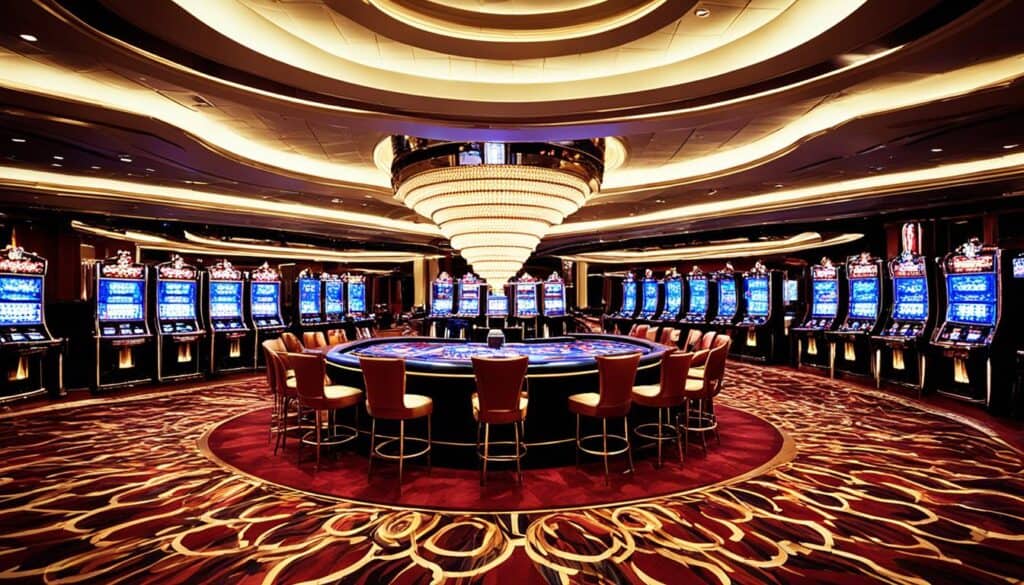
The layout of a casino plays a significant role in shaping player behavior and their level of engagement. Casino designers strategically use different layout techniques to create an immersive and captivating gambling experience for players.
One common design strategy is the use of maze-like layouts and unexpected pathways. By creating a sense of exploration in the casino, players are encouraged to move around and discover different gaming areas. This layout not only keeps players interested but also increases the chances of them stumbling upon new games or betting options.
In addition to maze-like layouts, casinos often incorporate clusters and smaller rooms within their design. This allows for a variety of gaming options and creates different atmospheres within the same space. Players can have unique experiences as they move from one room to another, providing a sense of adventure and discovery.
The well-thought-out layout of a casino can also influence player behavior in terms of risk-taking. By creating an engaging and exciting environment, players are more inclined to take risks and try new games. The design can help to alleviate any hesitation or fear that players may have, sparking their curiosity and desire to explore different betting options.
The Psychology Behind Casino Layout
“The layout of a casino is carefully crafted to manipulate player behavior and create an environment that maximizes engagement and satisfaction.”
The layout of a casino is not just about the placement of gaming machines and tables; it is about understanding player psychology. Casinos meticulously design their spaces to create a sense of comfort, excitement, and enticement.
By strategically placing gaming machines, using vibrant lighting, and incorporating visual stimulation, casinos captivate the attention of players and keep them engaged for longer periods. Every aspect of the design, from the placement of seating areas to the arrangement of walkways, is carefully considered to optimize the player experience.
The Importance of Sensory Stimulation in Casino Design
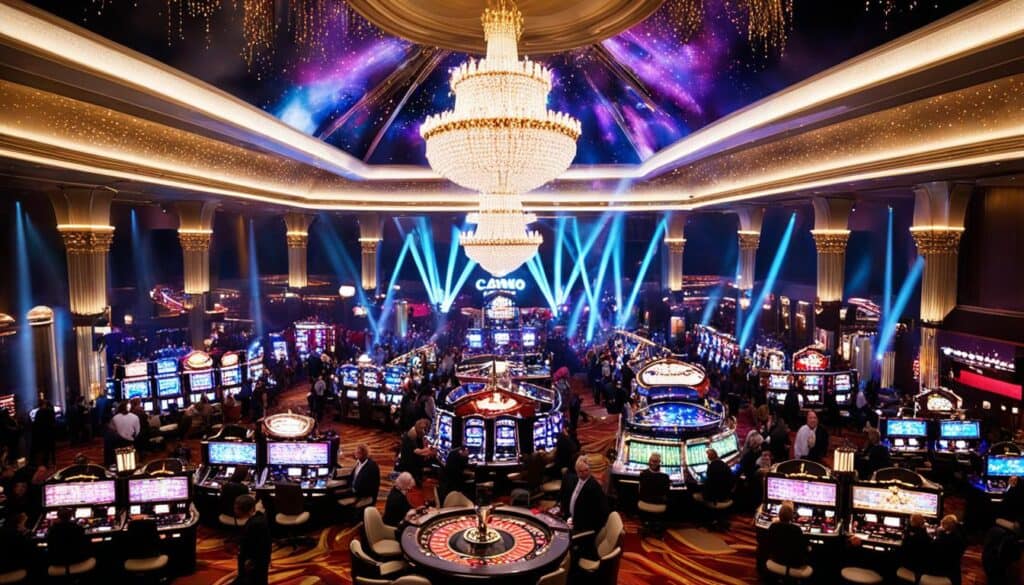
Sensory stimulation plays a vital role in casino design, greatly influencing player enjoyment and engagement. When designing a casino, strategic considerations such as lighting, music, and aromas can create an immersive atmosphere that enhances the overall gaming experience.
The use of bright lights, vibrant colors, and captivating visual elements adds excitement and energy to the casino environment. These elements draw players in and create a sense of anticipation and thrill. Coupled with carefully selected music, the auditory experience further enhances the overall ambiance, making it more enjoyable and engaging.
The sense of smell also plays a significant role in casino design. By incorporating pleasant aromas, such as the subtle scent of freshly brewed coffee or a hint of a floral fragrance, the casino can create a relaxing and inviting atmosphere. These aromas can evoke positive emotions and contribute to a memorable gaming experience.
By engaging players’ senses through strategic lighting, music, and aromas, casinos can create an alluring and immersive atmosphere that keeps players enthralled and wanting to stay longer. This heightened sensory experience enhances player enjoyment, leading to increased player satisfaction and longer gaming sessions.
The Evolution of Casino Design in the Digital Age
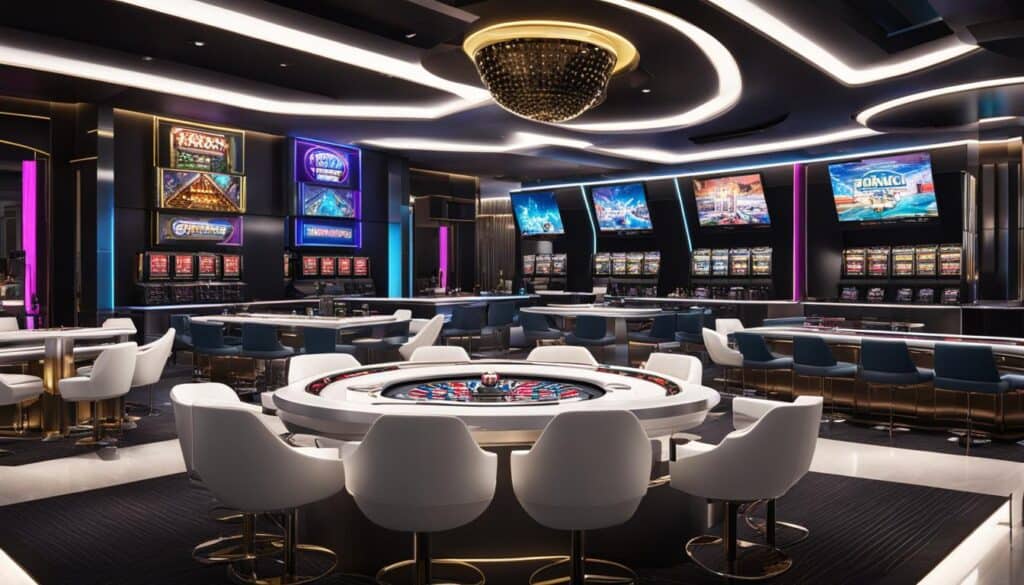
As online gambling continues to gain popularity, the design of virtual casinos has become increasingly important. Online casinos face the challenge of attracting and retaining players without the tangible ambiance and sensory stimulation of traditional brick-and-mortar establishments. To succeed in the competitive virtual gambling market, designers must prioritize user experience and accessibility for players.
One of the key factors in online casino design is creating a seamless and intuitive user experience. Players should be able to easily navigate the platform, find their favorite games, and engage with them effortlessly. Clear and user-friendly interfaces, as well as responsive design that adapts to different devices, are essential for a positive user experience.
The convenience of online gambling can be both a boon and a challenge. While it allows players to access their favorite games from the comfort of their homes, it also poses a risk of addiction. Designers must be mindful of this and find a balance between creating an engaging and enjoyable experience and ensuring responsible gambling practices.
Accessibility is another crucial aspect of online casino design. Designers need to ensure that the platform is accessible to all users, including those with disabilities. This may involve implementing features such as screen reader compatibility, keyboard navigation, and adjustable font sizes.
The digital age has also opened up new possibilities for immersive experiences in virtual casinos. Advanced technologies like virtual reality (VR) and augmented reality (AR) can enhance the gaming experience, allowing players to feel like they’re in a real casino environment. These technologies provide an opportunity for designers to create innovative and engaging experiences that rival the traditional casino atmosphere.
To mitigate the risk of addiction, designers should consider implementing responsible gambling features in online casinos. This may include setting limits on betting amounts and frequency, providing resources for self-exclusion, and promoting responsible gambling practices through educational content.
The Future of Online Casino Design
As technology continues to advance, the future of online casino design holds immense potential. Virtual casinos may incorporate artificial intelligence (AI) to personalize the gaming experience based on individual player preferences and behavior. This could lead to more tailored gameplay and targeted promotions.
Sustainability is another aspect that may shape the future of online casino design. With increased awareness of environmental issues, designers may prioritize eco-friendly practices in areas such as energy efficiency and waste reduction.
In conclusion, the evolution of casino design in the digital age presents both opportunities and challenges. Online casinos must strive to create engaging and immersive experiences while also prioritizing user experience, accessibility, and responsible gambling practices. As technologies continue to advance, the future of online casino design holds exciting possibilities for creating memorable and enjoyable virtual gambling experiences.
Iconic Casino Designs Around the World
![]()
When it comes to iconic casino designs, there are several world-famous casinos that have become architectural marvels and landmarks. These extraordinary establishments are renowned for their unique and extravagant designs that captivate visitors from around the globe.
One prime example is the Bellagio in Las Vegas. This luxurious resort and casino boasts a stunning lobby adorned with European-style furnishings, exquisite artwork, and opulent chandeliers. The Bellagio’s iconic design showcases the epitome of grandeur and elegance, attracting millions of guests each year.
Another famed casino is the Monte Carlo Casino in Monaco. Known for its grandeur and luxurious atmosphere, this architectural masterpiece has become a symbol of opulence and sophistication. With its stunning Belle Époque facade, ornate interiors, and breathtaking views of the Mediterranean Sea, the Monte Carlo Casino continues to enchant visitors with its timeless charm.
These landmark casinos are not only renowned for their iconic designs but also for their contributions to the world of gambling. They have set the standard for luxury and excess in the industry, inspiring countless other casinos to emulate their grandeur and allure.
The Future of Casino Architecture
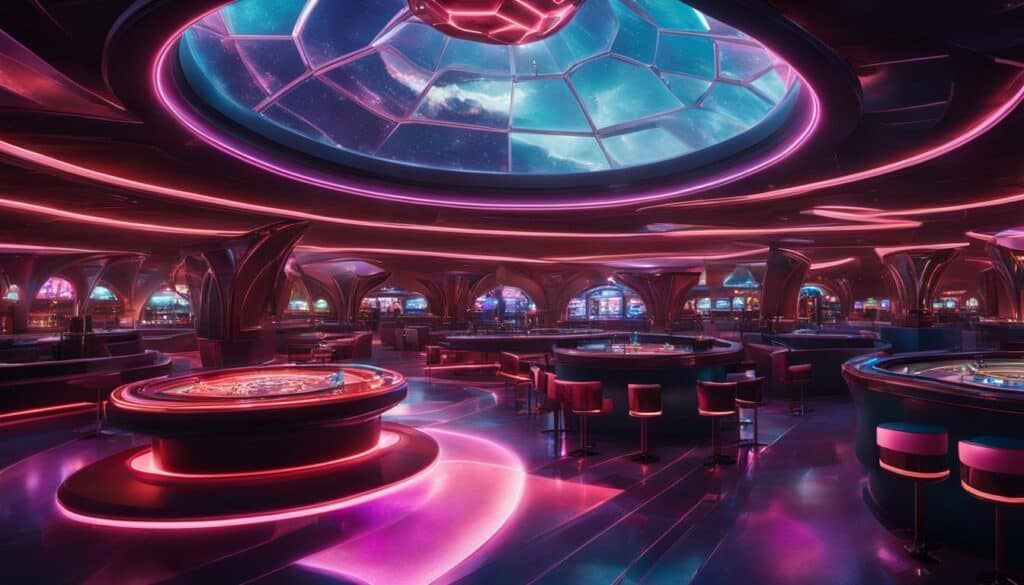
In the ever-changing world of casino architecture, the future holds exciting possibilities driven by technological advancements and evolving industry trends. As casinos strive to provide unforgettable experiences for their guests, integrating cutting-edge technology will play a key role in shaping the future of casino design.
One of the most promising developments in casino architecture is the potential adoption of virtual reality (VR) technology. With VR, casinos can transport players into immersive and interactive virtual worlds, providing a new level of engagement and excitement. Imagine stepping into a digital casino where you can explore different gaming realms and interact with virtual dealers and fellow players. This technology has the potential to revolutionize the way we experience gambling.
Sustainability is another crucial aspect that will shape the future of casino architecture. With a growing emphasis on eco-friendly practices, casinos are likely to incorporate sustainable design elements and energy-efficient systems. From using renewable energy sources to implementing green building materials, sustainability will play a significant role in creating environmentally responsible and socially conscious casino spaces.
The integration of smart technology and data analytics will unlock new opportunities for personalized experiences and targeted marketing strategies. By leveraging data insights, casinos can tailor their offerings to individual players, enhancing engagement and maximizing customer satisfaction. Smart technology can also improve operational efficiency, optimizing resource allocation and streamlining processes behind the scenes.
As the industry continues to evolve, casino architecture will adapt and innovate to meet the changing preferences and expectations of players. It is an exciting time where technological advancements, immersive experiences, sustainability, and personalized approaches converge to shape the future of casino design.
Key Takeaways:
- The future of casino architecture will be shaped by technological advancements and changing industry trends
- Virtual reality (VR) technology holds the potential to create immersive and interactive gaming experiences
- Sustainability will play a crucial role, with a focus on eco-friendly design and energy-efficient practices
- Smart technology and data analytics will enable personalized experiences and targeted marketing strategies
- Casino architecture will continue to adapt and innovate to meet the evolving needs and preferences of players
Casino Architecture: A Blend of Design and Psychology
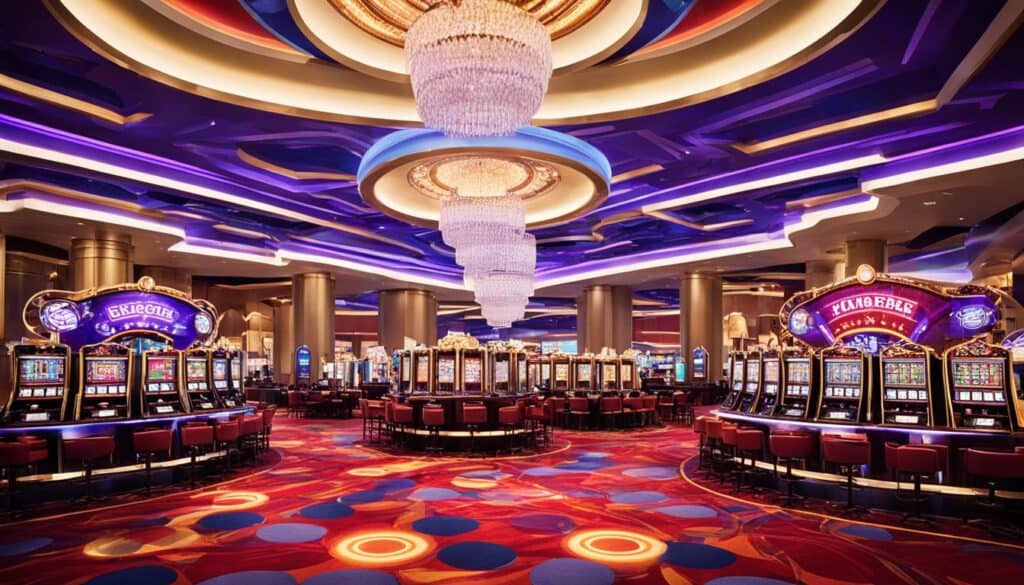
Casino architecture is a harmonious fusion of design principles and psychology that aims to create an environment that maximizes player engagement and profitability. Designers meticulously consider various factors such as space allocation, sensory stimulation, and player behavior when developing the layouts of casinos. By understanding the intricacies of human psychology and incorporating elements that appeal to players’ senses, designers are able to craft a captivating and enticing atmosphere.
The layout and design of a casino play a critical role in shaping the overall experience for players. An effective casino design should encourage exploration, creating a sense of intrigue and adventure within the space. This can be achieved through the strategic placement of gaming areas, pathways, and architectural features that guide players through the casino.
Furthermore, creating a sense of intimacy within the casino is essential to promote player comfort and engagement. By incorporating smaller rooms and segmented areas, designers can provide players with more personalized experiences and a greater sense of exclusivity. Additionally, the design should prioritize player comfort, with considerations such as seating arrangements and low ceilings to create a cozy and immersive ambiance.
The blend of design and psychology extends to the overall aesthetics and sensory elements of the casino. The lighting, music, and aromas within a casino can significantly impact the player’s emotions and overall enjoyment. Strategic use of lighting can enhance the excitement and energy of gaming areas, while carefully selected music and pleasant aromas further contribute to the immersive experience.
“The design of a casino should appeal to all the senses, creating a truly captivating environment that entices players to stay longer and enjoy the games,” says renowned casino architect, Jane Davis.
To maximize player engagement and profitability, the design of a casino should prioritize the placement and integration of gaming elements. Gaming machines should be strategically positioned and seamlessly integrated into the overall design, making them the focal point of the casino. Walkways and pathways should guide players towards the gaming areas, enticing them to participate in the games and prolong their stay.
By aligning design principles with an understanding of human psychology, casino architecture aims to create an environment that not only attracts players but also encourages longer gaming sessions and repeat visits. The blend of design and psychology in casino architecture ensures that players have a memorable and enjoyable experience, which ultimately contributes to the sustained success and profitability of the casino.
Conclusion
Casino architecture is a fascinating field that combines design principles, psychology, and industry trends to create captivating and profitable gambling spaces. Designers carefully consider factors such as space allocation and sensory stimulation to develop layouts that ensure player satisfaction and engagement. By understanding the psychology of players and incorporating elements that appeal to their senses, designers create an immersive and enjoyable environment that keeps players coming back for more.
As the casino industry continues to evolve, embracing technological advancements and incorporating sustainable practices, the future of casino architecture looks promising. The integration of smart technology and data analytics may enable more personalized experiences and targeted marketing strategies. Additionally, the focus on creating immersive and interactive gaming experiences through virtual reality technology will attract a wider audience.
Ultimately, the goal of casino architecture is to create spaces that not only provide entertainment but also maximize profitability. By prioritizing player satisfaction and engagement, designers create environments that enhance the overall gambling experience. As the industry moves forward, casino architecture will continue to adapt and innovate to meet the changing needs and preferences of players, ensuring that the future of gambling spaces remains immersive, enjoyable, and profitable.
FAQ
What is casino architecture?
Casino architecture refers to the design and layout of gambling spaces, with a focus on creating an alluring and engaging environment for gamblers. It combines design principles, psychology, and industry trends to maximize player satisfaction and profitability.
How does the design of a small casino differ from a larger one?
In a small casino, the design must carefully utilize limited space to create a vacation-like atmosphere. The layout should prioritize gaming areas, food and beverage corners, and parking space for convenience. The goal is to provide a comfortable and VIP-like experience to guests.
How do casino layouts manipulate human psychology?
Casino layouts are strategically designed to keep players engaged and immersed in the gambling experience. Elements such as the absence of clocks, maze-like pathways, and sensory stimulation create a sense of exploration and timelessness, encouraging players to stay longer.
Who are Bill Friedman and Roger Thomas, and how have they influenced casino design?
Bill Friedman and Roger Thomas are influential casino designers. Friedman focused on player retention, advocating for the elimination of time indicators and emphasizing gaming machines. Thomas revolutionized casino design by prioritizing player comfort, relaxation, and clear lines of vision.
What elements contribute to creating a captivating casino environment?
Elements such as strategic lighting, visually appealing decor, and prominent gaming machines contribute to a captivating casino environment. These factors create a visually stimulating and exciting atmosphere that entices players to stay and gamble.
What is the role of intimacy in casino design?
Intimacy in casino design is important for creating a personalized and engaging experience. By incorporating smaller rooms, segmented areas, and appropriate seating, casinos can create a sense of intimacy that keeps players comfortable and encourages longer playing sessions.
How do gaming elements impact casino design?
Gaming elements play a crucial role in attracting and keeping players’ attention. The design should strategically lead players to gaming machines and create a cohesive and immersive gaming experience. Placement, walkway design, and decor all contribute to player engagement.
How does casino layout influence player behavior?
Casino layouts are designed to influence player behavior by encouraging exploration and risk-taking. Maze-like layouts, unexpected pathways, and varied atmospheres within the casino promote adventure, keeping players engaged and inclined to try new games and stay longer.
What is the importance of sensory stimulation in casino design?
Sensory stimulation, through factors like lighting, music, and aromas, creates a vibrant and immersive atmosphere that enhances the overall gaming experience. Engaging players’ senses contributes to their enjoyment and keeps them coming back for more.
How is online casino design different from traditional casino design?
Online casino design focuses on user experience and accessibility, as there is no physical ambiance to rely on. Designers aim to create a platform that is easy to navigate and engages players. However, responsible use of online gambling platforms is essential to prevent addiction.
Are there any iconic casino designs around the world?
Yes, there are several iconic casino designs that have become architectural marvels and landmarks. Examples include the Bellagio in Las Vegas, known for its stunning lobby, and the Monte Carlo Casino in Monaco, renowned for its grandeur and luxurious atmosphere.
How will the future of casino architecture be influenced?
The future of casino architecture will be influenced by technological advancements, changing trends, and sustainability. Virtual reality technology may be incorporated to enhance immersive experiences, while smart technology and data analytics may enable personalized experiences and targeted marketing strategies.
What is the significance of casino architecture in player satisfaction and profitability?
Casino architecture combines design principles and psychology to create an environment that maximizes player engagement and profitability. By understanding human psychology and incorporating elements that appeal to players’ senses, designers can create a memorable and enjoyable experience that keeps players coming back for more.
 Online Gaming Circuit
Online Gaming Circuit

